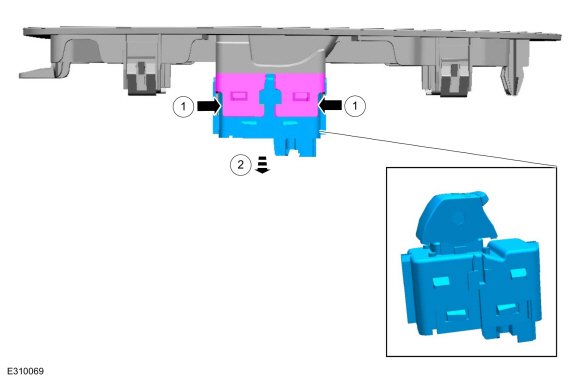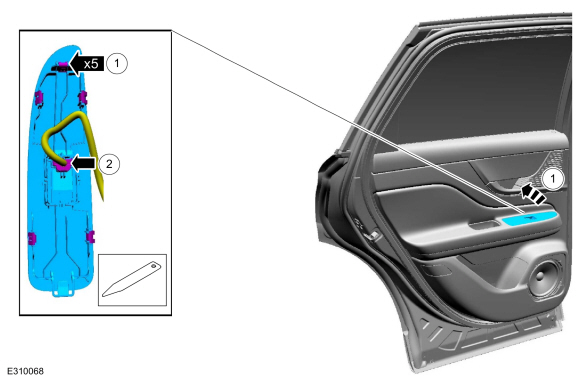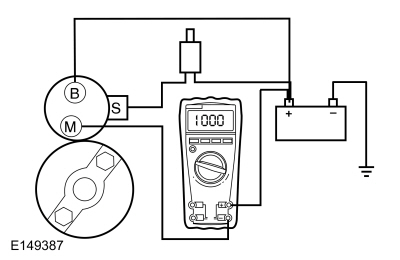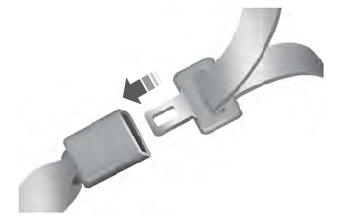Refer to Wiring Diagrams Cell 20 for schematic and connector information.
Normal Operation and Fault Conditions
REFER to: Starting System - System Operation and Component Description
(303-06A Starting System - 1.5L EcoBoost (132kW/180PS) – I3 (Y1),
Description and Operation).
DTC Fault Trigger Conditions
| DTC |
Description |
Fault Trigger Condition |
| PCM P06E9:00 |
Engine Starter Performance: No Sub Type Information |
The PCM sets this DTC when no engine rotation is detected during a crank event.
|
| BCM P0830:11 |
Clutch Pedal Switch 'A' Circuit: Circuit Short To Ground |
The BCM sets this DTC when a short to ground is detected on the clutch bottom of travel circuit during an on-demand self test.
|
Possible Sources
- Battery
- Battery cables
-
IPC
- Starter motor
-
BJB starter relay
Visual Inspection and Pre-checks
- Inspect the run/start relay.
- Inspect the high current BJB connections.
- Verify the BJB fuse 10 (30A).
- Inspect the passive key.
- Inspect the CPP switch.
|
| B1 PERFORM INSPECTION AND VERIFICATION |
-
NOTE:
Make sure battery voltage is greater than 12.2 volts prior to and during this pinpoint test.
NOTE:
If it is necessary to leave the battery charger
connected during testing, do not leave it on its highest or boost
setting. The highest settings can exceed 16 volts, resulting in false
test results and setting of DTCs.
Perform Inspection and Verification procedure in this section.
Was an obvious cause for an observed or reported concern found?
| Yes |
CORRECT the cause as necessary.
|
|
| B2 CHECK FOR NO KEY DETECTED MESSAGE IN THE MESSAGE CENTER |
-
NOTE:
There are certain areas inside the vehicle where
the passive key may not be detected and the message center displays NO
KEY DETECTED. If the passive key is in the far outside edges of the
interior (like in a door map pocket or above a sun visor) it might not
be detected. Move the passive key to a different location and try to
start the vehicle again.
Check the message displayed in the message center while pressing the ignition switch - push button start.
Is NO KEY DETECTED displayed?
| Yes |
DIAGNOSE the NO KEY DETECTED concern. REFER to:
Passive Anti-Theft System (PATS) (419-01, Diagnosis and Testing).
|
|
| B3 VERIFY THE BCM (BODY CONTROL MODULE)
, IPC (INSTRUMENT PANEL CLUSTER)
AND PCM (POWERTRAIN CONTROL MODULE)
PASS THE NETWORK TEST |
-
Using a diagnostic scan tool, perform the Network Test.
Did the BCM , IPC and PCM pass the Network Test?
| No |
REFER to: Communications Network (418-00 Module Communications Network, Diagnosis and Testing).
|
|
| B4 RETRIEVE BCM (BODY CONTROL MODULE)
DIAGNOSTIC TROUBLE CODES (DTCS) |
-
Using a diagnostic scan tool, perform BCM self-test.
Are any BCM Diagnostic Trouble Codes (DTCs) present?
| Yes |
For DTC P0830:11 GO to B26
For all BCM Diagnostic Trouble Codes (DTCs), REFER to the BCM DTC Chart in this section.
|
|
| B5 RETRIEVE PCM (POWERTRAIN CONTROL MODULE)
DIAGNOSTIC TROUBLE CODES (DTCS) |
-
Using a diagnostic scan tool, perform PCM self-test.
Are any PCM Diagnostic Trouble Codes (DTCs) other than P06E9 present?
| Yes |
REFER to the PCM DTC Chart in this section.
|
| No |
With automatic transmission, GO to B6
With manual transmission, GO to B11
|
|
| B6 CHECK THE OPERATION OF THE STOPLAMPS |
-
While observing the stoplamps, apply the brake pedal.
Do the stoplamps illuminate?
| No |
DIAGNOSE All the Stoplamps are inoperative.
REFER to: Stoplamps (417-01 Exterior Lighting, Diagnosis and Testing).
|
|
| B7 CHECK THE BRAKE PEDAL POSITION (BOO1) PID (PARAMETER IDENTIFICATION)
|
-
Using a diagnostic scan tool, view PCM Parameter Identifications (PIDs).
-
Monitor the PCM B001 PID while applying the brake pedal.
Does the PID read On?
|
| B8 CHECK THE BPP (BRAKE PEDAL POSITION)
SWITCH CIRCUIT FOR VOLTAGE AT THE PCM (POWERTRAIN CONTROL MODULE)
|
-
While applying the brake pedal, measure:
Click to display connectors
|
Positive Lead
|
Measurement / Action
|
Negative Lead
|
|
C175B-11
|
.jpg)
|
Ground
|
Is the voltage greater than 11 volts?
|
| B9 CHECK BCM (BODY CONTROL MODULE)
IGN_SW_STATE PID (PARAMETER IDENTIFICATION)
|
-
Using a diagnostic scan tool, view the BCM Parameter Identifications (PIDs).
-
Make sure the transmission is in PARK or NEUTRAL.
-
Monitor the BCM
PID IGN_SW_STATE while turning the ignition switch from OFF to START.
Does the PID change from Off to Start when the ignition switch is turned from OFF to START?
| No |
DIAGNOSE No power in ON.
REFER to: Steering Wheel and Column
Electrical Components (211-05 Steering Wheel and Column Electrical
Components, Diagnosis and Testing).
|
|
| B10 CHECK THE TRANSMISSION RANGE INPUT ALLOWING ENGINE START (TR_CRANK) PID (PARAMETER IDENTIFICATION)
|
-
Using a diagnostic scan tool, view the PCM Parameter Identifications (PIDs).
-
Monitor the PCM
PID TR_CRANK, while placing the gear selector in PARK and then NEUTRAL.
Does the PID read Yes in both positions?
| No |
REFER to: DTC Chart and Pinpoint Tests - 2.0L EcoBoost
(177kW/240PS) – MI4 (307-01A Automatic Transmission - 8-Speed Automatic
Transmission – 8F35/8F40, Diagnosis and Testing).
|
|
| B11 CHECK THE PCM (POWERTRAIN CONTROL MODULE)
CLUTCH PEDAL AT OR NEAR BOTTOM OF TRAVEL (CPP_BOT) PID (PARAMETER IDENTIFICATION)
|
-
Using a diagnostic scan tool, while viewing the PCM
PID CPP_BOT, fully apply the clutch pedal and release.
Does the PID change from NO to YES when the clutch pedal is fully applied?
|
| B12 CHECK THE PCM (POWERTRAIN CONTROL MODULE)
ENGINE CRANKING (ENG_CRANK) PID (PARAMETER IDENTIFICATION)
|
-
Using a diagnostic scan tool, view the PCM Parameter Identifications (PIDs).
-
For automatic transmission, make sure the transmission is in PARK or NEUTRAL.
-
For manual transmission, fully apply the clutch pedal.
-
Using a diagnostic scan tool, view the PCM PID ENG_CRANK, while holding the key in the START position.
Does the PID change from Inactive to Active?
|
| B13 CHECK THE BJB (BATTERY JUNCTION BOX)
STARTER RELAY FUSE |
-
Verify the BJB fuse 36 (30A).
Was the fuse OK?
| No |
REPAIR the circuit for a short to ground.
|
|
| B14 CHECK FOR START REQUEST AT THE STARTER |
-
Disconnect Starter solenoid C197B
.
-
While pressing the ignition switch - push button
start and the brake pedal (with automatic transmission) or fully apply
the clutch pedal (with manual transmission), measure:
Click to display connectors
|
Positive Lead
|
Measurement / Action
|
Negative Lead
|
|
C197B-1 ("S" terminal)
|
.jpg)
|
Ground
|
Is the voltage greater than 11 volts?
| No |
Connect Starter solenoid C197B and GO to B15
|
|
| B15 CHECK THE STARTER MOTOR CONTROL OPERATION |
-
Disconnect
BJB Relay Module C1035A
.
-
Connect a remote starter switch:
|
Positive Lead
|
Measurement / Action
|
Negative Lead
|
|
C1035A-50
|
Remote Starter Switch
|

|
-
Momentarily engage the remote starter switch.
Does the engine crank?
| No |
REPAIR circuit for open.
|
|
| B16 CHECK THE PCM (POWERTRAIN CONTROL MODULE)
STARTER RELAY CONTROL CIRCUITS FOR A SHORT TO VOLTAGE |
-
Connect
BJB Relay Module C1035A
.
-
Measure:
Click to display connectors
|
Positive Lead
|
Measurement / Action
|
Negative Lead
|
|
C175B-69
|
.jpg)
|
Ground
|
|
C175B-71
|
.jpg)
|
Ground
|
Is any voltage present?
| Yes |
REPAIR the affected circuit.
|
|
| B17 CHECK THE PCM (POWERTRAIN CONTROL MODULE)
STARTER RELAY CONTROL CIRCUITS FOR A SHORT TO GROUND |
-
Disconnect
BJB Relay Module C1035A
.
-
Measure:
Click to display connectors
|
Positive Lead
|
Measurement / Action
|
Negative Lead
|
|
C175B-69
|
.jpg)
|
Ground
|
|
C175B-71
|
.jpg)
|
Ground
|
Are the resistances greater than 10,000 ohms?
| No |
REPAIR the affected circuit.
|
|
| B18 CHECK THE PCM (POWERTRAIN CONTROL MODULE)
STARTER RELAY CONTROL CIRCUITS FOR AN OPEN |
-
Measure:
Click to display connectors
|
Positive Lead
|
Measurement / Action
|
Negative Lead
|
|
C175B-69
|
.jpg)
|
C1035A-7
|
|
C175B-71
|
.jpg)
|
C1035A-7
|
Are the resistances less than 3 ohms?
| Yes |
INSTALL a new BJB relay module.
|
| No |
REPAIR the affected circuit. CHECK the system for proper operation. If engine will still not crank, GO to B29
|
|
| B19 CHECK THE STARTER MOTOR FOR CORRECT OPERATION |
-
Perform Starter Motor - Positive Circuit Test in this section.
Was an obvious cause found?
| Yes |
Correct the cause as necessary.
|
|
| B20 CHECK THE BATTERY GROUND CABLES |
-
Measure:
|
Positive Lead
|
Measurement / Action
|
Negative Lead
|

|
.jpg)
|
Ground G111
|
Are the voltages greater than 11 volts?
| No |
CLEAN or INSTALL new negative battery cables as
necessary. REFER to: Battery Cables - 1.5L EcoBoost (132kW/180PS) -
I3/1.5L EcoBoost (110kW/150PS) - I3 (YZ), (414-01, Removal and
Installation).
|
|
| B21 CHECK THE STARTER MOTOR GROUND |
-
Measure:
|
Positive Lead
|
Measurement / Action
|
Negative Lead
|

|
.jpg)
|
 Starter motor case
Starter motor case
|
Is the voltage greater than 11 volts?
| No |
CLEAN the starter motor mounting flange and MAKE
SURE the starter motor is correctly mounted. REFER to: Starter Motor
(303-06, Removal and Installation).
|
|
| B22 CHECK THE VOLTAGE TO THE STARTER MOTOR |
-
Measure:
Click to display connectors
|
Positive Lead
|
Measurement / Action
|
Negative Lead
|
|
C197A-1 ("B" terminal)
|
.jpg)
|
Ground
|
Is the voltage greater than 11 volts?
| Yes |
INSTALL a new starter motor. REFER to: Starter Motor (303-06, Removal and Installation).
|
| No |
INSTALL a new positive battery cable. REFER to:
Battery Cables - 1.5L EcoBoost (132kW/180PS) - I3/1.5L EcoBoost
(110kW/150PS) - I3 (YZ), (414-01, Removal and Installation).
|
|
| B23 CHECK THE CPP (CLUTCH PEDAL POSITION)
SWITCH OPERATION |
-
While fully applying the clutch pedal, measure:
Click to display connectors
|
Positive Lead
|
Measurement / Action
|
Negative Lead
|
|
C2280D-48
|
.jpg)
|
Ground
|
Is the resistance less than 3 ohms?
|
| B24 CHECK THE CPP (CLUTCH PEDAL POSITION)
GROUND CIRCUIT FOR AN OPEN |
-
Disconnect
CPP switch C2353
.
-
Measure:
Click to display connectors
|
Positive Lead
|
Measurement / Action
|
Negative Lead
|
|
C2353-2
|
.jpg)
|
Ground
|
Is the resistance less than 3 ohms?
|
| B25 CHECK THE CPP (CLUTCH PEDAL POSITION)
SWITCH CIRCUIT FOR AN OPEN |
-
Measure:
Click to display connectors
|
Positive Lead
|
Measurement / Action
|
Negative Lead
|
|
C2280D-48
|
.jpg)
|
C2353-1
|
Is the resistance less than 3 ohms?
| Yes |
INSTALL a new CPP
switch.
REFER to: Clutch Pedal Position (CPP) Switch
(303-14 Electronic Engine Controls - 1.5L EcoBoost (132kW/180PS) -
I3/1.5L EcoBoost (110kW/150PS) - I3 (YZ), Removal and Installation).
|
|
| B26 CHECK FOR DTC WITH CPP (CLUTCH PEDAL POSITION)
SWITCH DISCONNECTED |
-
Disconnect
CPP switch C2353
.
-
Using a diagnostic scan tool, perform BCM self-test.
Was DTC P0830:11 retrieved during on-demand self-test with the CPP switch disconnected?
| No |
INSTALL a new CPP
switch.
REFER to: Clutch Pedal Position (CPP) Switch
(303-14 Electronic Engine Controls - 1.5L EcoBoost (132kW/180PS) -
I3/1.5L EcoBoost (110kW/150PS) - I3 (YZ), Removal and Installation).
|
|
| B27 CHECK THE CLUTCH BOTTOM OF TRAVEL CIRCUIT FOR A SHORT TO GROUND |
-
Measure:
Click to display connectors
|
Positive Lead
|
Measurement / Action
|
Negative Lead
|
|
C2280D-48
|
.jpg)
|
Ground
|
Is the resistance greater than 10,000 ohms?
|
| B28 CHECK PCM (POWERTRAIN CONTROL MODULE)
FOR CRANK REQUEST |
-
While holding the key in the START position, measure:
Click to display connectors
|
Positive Lead
|
Measurement / Action
|
Negative Lead
|
|
C175B-45
|
.jpg)
|
Ground
|
Is the voltage greater than 11 volts?
| No |
REPAIR circuit for open.
|
|
| B29 CHECK FOR CORRECT PCM (POWERTRAIN CONTROL MODULE)
OPERATION |
-
Disconnect and inspect all PCM connectors.
-
Repair:
-
corrosion (install new connectors or terminals - clean module pins)
-
damaged or bent pins - install new terminals/pins
-
pushed-out pins - install new pins as necessary
-
Reconnect the PCM connectors. Make sure they seat and latch correctly.
-
Operate the system and determine if the concern is still present.
Is the concern still present?
| Yes |
CHECK OASIS for any applicable Technical Service Bulletins (TSBs). If a
TSB exists for this concern, DISCONTINUE this test and FOLLOW the TSB
instructions. If no Technical Service Bulletins (TSBs) address this
concern,
.GIF)  VIN required to access Guided Routine (PCM) VIN required to access Guided Routine (PCM)
|
| No |
The system is operating correctly at this time. The
concern may have been caused by module connections. ADDRESS the root
cause of any connector or pin issues.
|
|
| B30 CHECK FOR CORRECT BCM (BODY CONTROL MODULE)
OPERATION |
-
Disconnect and inspect all BCM connectors.
-
Repair:
-
corrosion (install new connectors or terminals - clean module pins)
-
damaged or bent pins - install new terminals/pins
-
pushed-out pins - install new pins as necessary
-
Reconnect the BCM connectors. Make sure they seat and latch correctly.
-
Operate the system and determine if the concern is still present.
Is the concern still present?
| Yes |
CHECK OASIS for any applicable Technical Service Bulletins (TSBs). If a
TSB exists for this concern, DISCONTINUE this test and FOLLOW the TSB
instructions. If no Technical Service Bulletins (TSBs) address this
concern, INSTALL a new BCM .
REFER to: Body Control Module (BCM) (419-10 Multifunction Electronic Modules, Removal and Installation).
|
| No |
The system is operating correctly at this time. The
concern may have been caused by module connections. ADDRESS the root
cause of any connector or pin issues.
|
|
.jpg) PINPOINT TEST A: ENGINE DOES NOT CRANK- WITHOUT PUSH-BUTTON START
PINPOINT TEST A: ENGINE DOES NOT CRANK- WITHOUT PUSH-BUTTON START.jpg) PINPOINT TEST B: ENGINE DOES NOT CRANK - WITH PUSH-BUTTON START
PINPOINT TEST B: ENGINE DOES NOT CRANK - WITH PUSH-BUTTON START .jpg) PINPOINT TEST C: UNUSUAL STARTER NOISE
PINPOINT TEST C: UNUSUAL STARTER NOISE.jpg) PINPOINT TEST D: C113A:11, C113A:15
PINPOINT TEST D: C113A:11, C113A:15.jpg) PINPOINT TEST E: P2535 (WITHOUT PUSH BUTTON START)
PINPOINT TEST E: P2535 (WITHOUT PUSH BUTTON START).jpg) PINPOINT TEST F: P2535 (WITH PUSH BUTTON START)
PINPOINT TEST F: P2535 (WITH PUSH BUTTON START) .jpg) PINPOINT TEST G: DTC P06E4
PINPOINT TEST G: DTC P06E4.jpg) PINPOINT TEST H: DTC P162F
PINPOINT TEST H: DTC P162F.jpg) PINPOINT TEST I: THE ENGINE CRANKS SLOWLY
PINPOINT TEST I: THE ENGINE CRANKS SLOWLY.jpg) PINPOINT TEST J: THE STARTER SPINS BUT THE ENGINE DOES NOT CRANK
PINPOINT TEST J: THE STARTER SPINS BUT THE ENGINE DOES NOT CRANK.jpg) PINPOINT TEST K: THE STARTER DOES NOT DISENGAGE FROM THE FLEXPLATE
PINPOINT TEST K: THE STARTER DOES NOT DISENGAGE FROM THE FLEXPLATE.jpg) PINPOINT TEST L: AUTO-START-STOP SYSTEM IS INOPERATIVE OR DOES NOT OPERATE CORRECTLY
PINPOINT TEST L: AUTO-START-STOP SYSTEM IS INOPERATIVE OR DOES NOT OPERATE CORRECTLY.jpg) PINPOINT TEST M: AUTO-START-STOP SYSTEM CANNOT BE DISABLED BY DRIVER
PINPOINT TEST M: AUTO-START-STOP SYSTEM CANNOT BE DISABLED BY DRIVER
.jpg)
 General Procedures - Starter Amperage Draw Test
General Procedures - Starter Amperage Draw Test

.jpg) PINPOINT TEST A: ENGINE DOES NOT CRANK- WITHOUT PUSH-BUTTON START
PINPOINT TEST A: ENGINE DOES NOT CRANK- WITHOUT PUSH-BUTTON START.jpg)

.jpg)
 Starter motor case
Starter motor case
 VIN required to access Guided Routine (PCM)
VIN required to access Guided Routine (PCM)
